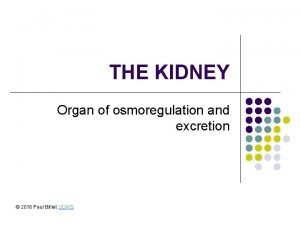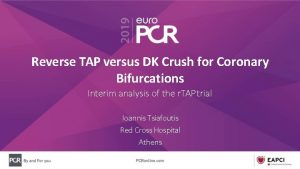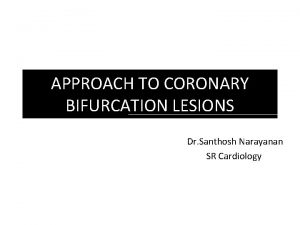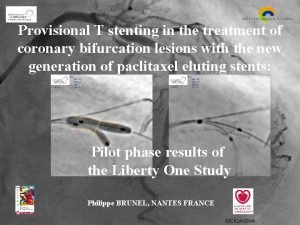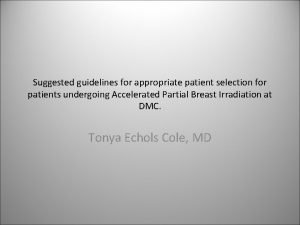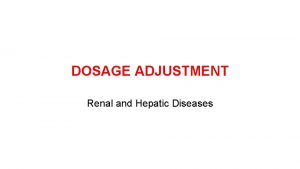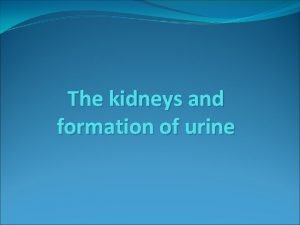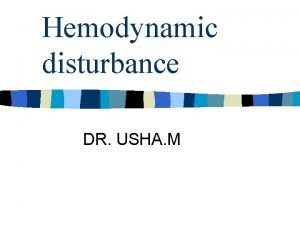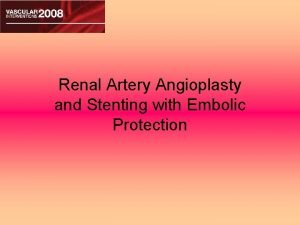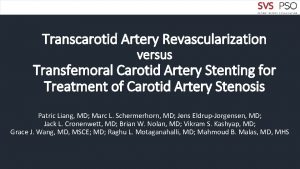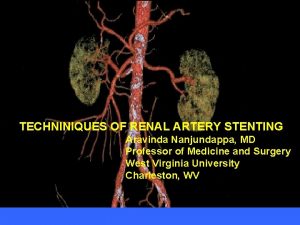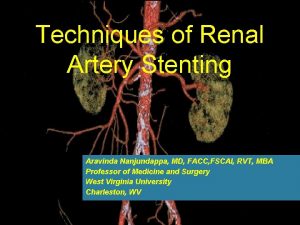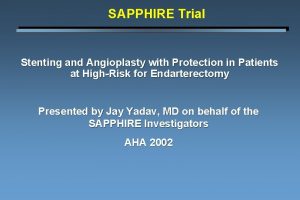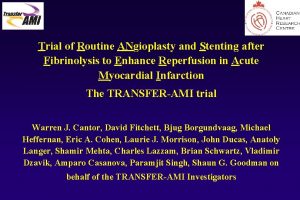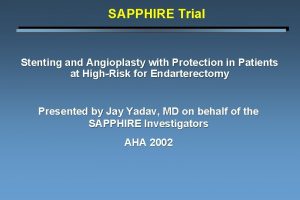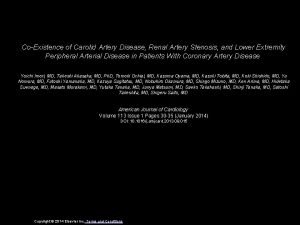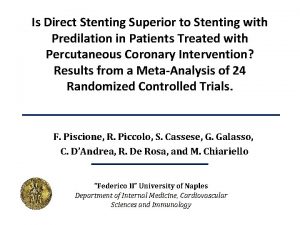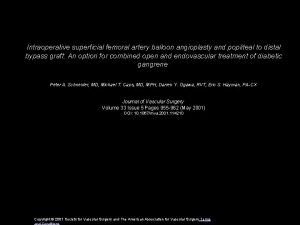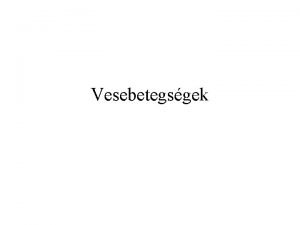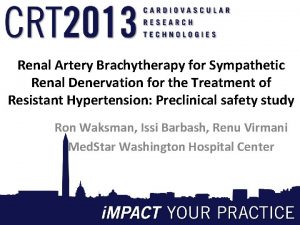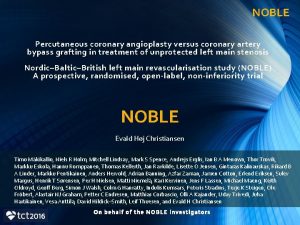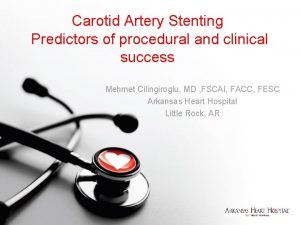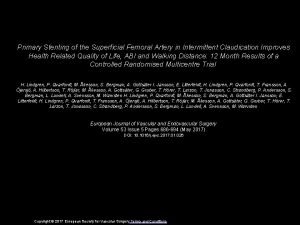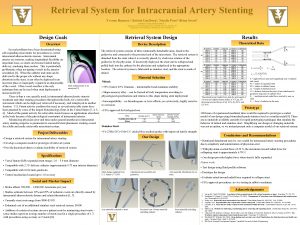Renal Artery Angioplasty and Stenting Optimal Patient Selection



























- Slides: 27

Renal Artery Angioplasty and Stenting: Optimal Patient Selection Ehtisham Mahmud, MD, FACC Division Chief, Cardiovascular Medicine Director, Sulpizio Cardiovascular Center-Medicine University of California, San Diego

Disclosures n Clinical trial support: Corindus n Consulting: Corindus, Medtronic n Speakers Bureau: Medtronic, Abbott Vascular

Renal Artery Revascularization n Hypertension management n Renal function preservation n Renal artery angioplasty -fibromuscular dysplasia -otherwise replaced by aorto-ostial stenting n Renal stenting -predictors of response

Renal Fibromuscular Dysplasia: IVUS Evaluation Prasad, Mahmud et al; Cath Cardiovasc Intv 2009; 74: 260 -4

Fibromuscular Dysplasia A B C D Mahmud et al; Catheter Cardiovasc Intv 2006; 67: 434 -7

Uncontrolled HTN and unilateral RAS 90% stenosis Stents back to ostia 61 year old man with uncontrolled hypertension (BP 165/100 mm Hg despite 3 antihypertensives) Mahmud et al; JACC 2007; 473 -90

Blood Pressure Zeller at al. Circulation 2003; 108: 2244 -9

ASPIRE 2 Study n n n N=208; multicenter 20 mm Hg systolic BP reduction at 12 and 24 mos Stable creatinine Restenosis: 17. 4% 39% non-responders!! Rocha-Singh et al; JACC 2005; 46: 776 -783 Mahmud JACC 2005; 46: 784 -786

Blood Pressure Response in Unilateral Renal Artery Stenosis Mahmud et al; JACC Intv 2008; 1: 286 -92 Whitlow; JACC Intv 2008; 1: 293 -294

Renal Frame Count • Control group • BP>140/90 mm. Hg; 2 meds • No renal artery stenosis • Study group • BP>140/90 mm. Hg; 2 meds • Renal artery stenosis >70% Mahmud et al; JACC Intv 2008; 1: 286 -92

Renal Frame Count Reduction Predicts Clinical Response to Renal Stenting Mahmud et al; JACC Intv 2008; 1: 286 -92

Baseline Renal Frame Count and Blood Pressure Reduction After Renal Stenting Naghi, Mahmud et al; Cath Cardiovasc Intv 2015; 86: 304 -309

Renal Resistive Index: Prognostic Value Radermacher J, et al. NEJM 2001; 344: 410 -7

ASTRAL: Blood Pressure ASTRAL Investigators; NEJM 2009; 361: 1953 -62

Randomized Trials: Major Concern STAR Bax et al; Ann Intern Med 2009: 840 -48 ASTRAL Astral Invest; NEJM 2009; 361: 1953 -62

Effects of a balloon-induced, unilateral, controlled, graded stenosis and renin production De Bruyne, B. et al. J Am Coll Cardiol 2006; 48: 1851 -1855 Copyright © 2006 American College of Cardiology Foundation. Restrictions may apply.

Fractional Flow Reserve and Clinical Response to Renal Stenting • Group I: FFR<0. 80 • Group II: FFR>0. 80 • N=17 • Papaverine for dilation Mitchell et al; Catheter Cardiovasc Interv. 2007; 69(5): 685 -9

Representative Example of Quantitative Renal Angiography, IVUS, and TPG in a Study Patient With RAS Leesar, M. A. et al. J Am Coll Cardiol 2009; 53: 2363 -2371 Copyright © 2009 American College of Cardiology Foundation. Restrictions may apply.

Receiver-Operating Characteristic Curves of HSG, FFR, IVUS, and Diameter Stenosis for Hypertension Improvement Leesar, M. A. et al. J Am Coll Cardiol 2009; 53: 2363 -2371 Copyright © 2009 American College of Cardiology Foundation. Restrictions may apply.

Blood Pressure Response after Renal Stenting: HSG >=21 Versus <21 mm Hg Leesar, M. A. et al. J Am Coll Cardiol 2009; 53: 2363 -2371 Copyright © 2009 American College of Cardiology Foundation. Restrictions may apply.

Number of Antihypertensive Medications and Serum Creatinine After Renal Stenting: HSG >=21 vs <21 mm Hg Leesar, M. A. et al. J Am Coll Cardiol 2009; 53: 2363 -2371 Copyright © 2009 American College of Cardiology Foundation. Restrictions may apply.

Bilateral renal artery stenosis and renal dysfunction 99% stenosis Stent back to ostium 74 year old woman with an dysfunctional left kidney and creatinine increase from 1. 9 to 4 mg/dl over two years

Stenting: Salvage Renal Function N=51 patients 42 bilateral RAS Rocha-Singh et al; Cath Cardio Interv 2002; 57: 135 -41

Renal Artery Stenosis: Clinical n Indications for treatment (clinical presentation): n n n Renovascular hypertension (BP ≥ 140/90 mm Hg; ≥ 2 antihypertensives) especially young or new onset elderly Ambulatory BP monitoring rather than single measurement Progressive, accelerated renal insufficiency Recurrent/flash pulmonary edema Global renal ischemia

n Renal Artery Stenosis: Markers of Success Anatomical features: n n Physiological measures: n n n Kidney >8 cm Angiographic diameter stenosis >70% by QRA IVUS CSA stenosis >80% Resistive index <0. 80 Mean Pd: Pa <0. 80 (renal FFR) Hyperemic systolic gradient ≥ 21 mm Hg Increased baseline renal frame count (>30) and RBG≥ 1 Novel measures: n n Decreased RFC after renal stenting Biomarkers/New Imaging: BNP, renal penumbra

n Renal Artery Stenosis: Markers of Success Anatomical features: n n Physiological measures: n n n Kidney >8 cm Angiographic diameter stenosis >70% by QRA IVUS CSA stenosis >80% Resistive index <0. 80 Mean Pd: Pa <0. 80 (renal FFR) Hyperemic systolic gradient ≥ 21 mm Hg Increased baseline renal frame count (>30) and RBG≥ 1 Novel measures: n n Decreased RFC after renal stenting Biomarkers/New Imaging: BNP, renal penumbra

n Renal Artery Stenosis: Markers of Success Anatomical features: n n Physiological measures: n n n Kidney >8 cm Angiographic diameter stenosis >70% by QRA IVUS CSA stenosis >80% Resistive index <0. 80 Mean Pd: Pa <0. 80 (renal FFR) Hyperemic systolic gradient ≥ 21 mm Hg Increased baseline renal frame count (>30) and RBG≥ 1 Novel measures: n n Decreased RFC after renal stenting Biomarkers/New Imaging: BNP, renal penumbra
 Ira pré renal renal e pós renal
Ira pré renal renal e pós renal Diagnostico etiologico
Diagnostico etiologico Distinguish between renal corpuscle and renal tubule
Distinguish between renal corpuscle and renal tubule Mesenteric artery origin
Mesenteric artery origin Osmoregulation
Osmoregulation Tap bifurcation technique
Tap bifurcation technique Mini culotte stenting
Mini culotte stenting Inverted provisional stenting
Inverted provisional stenting Patient 2 patient
Patient 2 patient Two way selection and multiway selection in c
Two way selection and multiway selection in c Multiway selection in c
Multiway selection in c Mass selection and pure line selection
Mass selection and pure line selection Appropriate patient selection
Appropriate patient selection Balancing selection vs stabilizing selection
Balancing selection vs stabilizing selection Similarities
Similarities K selection r selection
K selection r selection Natural selection vs artificial selection
Natural selection vs artificial selection Artificial selection vs natural selection
Artificial selection vs natural selection Stabilizing selection human birth weight
Stabilizing selection human birth weight Clumped dispersion
Clumped dispersion Natural selection vs artificial selection
Natural selection vs artificial selection What is renal lobule
What is renal lobule Loading dose formula
Loading dose formula Transitional epithelium ureter
Transitional epithelium ureter Function of nephron in points
Function of nephron in points Edema lesion
Edema lesion How to achieve optimal health and wellness
How to achieve optimal health and wellness Optimal driver launch angle and spin rate chart
Optimal driver launch angle and spin rate chart




